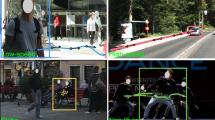Abstract
Two crucial aspects of general-purpose embedded visual point tracking are addressed in this paper. First, the algorithm should reliably track as many points as possible. Second, the computation should achieve real-time video processing, which is challenging on low power embedded platforms. We propose a new multi-scale semi-dense point tracker called Video Extruder, whose purpose is to fill the gap between short-term, dense motion estimation (optical flow) and long-term, sparse salient point tracking. This paper presents a new detector, including a new salience function with low computational complexity and a new selection strategy that allows to obtain a large number of keypoints. Its density and reliability in mobile video scenarios are compared with those of the FAST detector. Then, a multi-scale matching strategy is presented, based on hybrid regional coarse-to-fine and temporal prediction, which provides robustness to large camera and object accelerations. Filtering and merging strategies are then used to eliminate most of the wrong or useless trajectories. Thanks to its high degree of parallelism, the proposed algorithm extracts beams of trajectories from the video very efficiently. We compare it with the state-of-the-art pyramidal Lucas–Kanade point tracker and show that, in short range mobile video scenarios, it yields similar quality results, while being up to one order of magnitude faster. Three different parallel implementations of this tracker are presented, on multi-core CPU, GPU and ARM SoCs. On a commodity 2010 CPU, it can track 8,500 points in a 640 × 480 video at 150 Hz.










Similar content being viewed by others
References
Botella, G., Martín, H.J.A., Santos, M., Meyer-Baese, U.: FPGA-based multimodal embedded sensor system integrating low- and mid-level vision. Sensors 11(12), 8164–8179 (2011). doi:10.3390/s110808164, URL: http://www.mdpi.com/1424-8220/11/8/8164/
Bouchafa, S., Zavidovique, B.: c-velocity: a flow-cumulating uncalibrated approach for 3d plane detection. Int. J. Comput. Vis. 97(2), 148–166 (2012)
Bouguet, J.Y.: Pyramidal implementation of the affine Lucas Kanade feature tracker description of the algorithm. Intel Corporation (2001)
Brostow, G.J., Shotton, J., Fauqueur, J., Cipolla, R.: Segmentation and recognition using structure from motion point clouds. In: ECCV (1) pp. 44–57 (2008)
Chaudhry, R., Ravichandran, A., Hager, G., Vidal, R.: Histograms of oriented optical flow and Binet–Cauchy kernels on nonlinear dynamical systems for the recognition of human actions. In: Computer Vision and Pattern Recognition, CVPR 2009, IEEE Conference, pp. 1932–1939 (2009)
d’Angelo, E., Paratte, J., Puy, G., Vandergheynst, P.: Fast TV-L1 optical flow for interactivity. In: IEEE International Conference on Image Processing (ICIP’11), pp. 1925–1928. Brussels (2011)
Doyle, D.D., Jennings, A.L., Black, J.T.: Optical flow background estimation for real-time pan/tilt camera object tracking. Measurement 48, 195–207 (2014). doi:10.1016/j.measurement.2013.10.025, URL: http://linkinghub.elsevier.com/retrieve/pii/S0263224113005241
Farnebäck, G.: Two-frame motion estimation based on polynomial expansion. In: Image Analysis, Springer, pp. 363–370 (2003)
Fassold, H., Rosner, J., Schallaeur, P., Bailer, W.: Realtime KLT feature point tracking for high definition video. In: Computer Graphics, Computer Vision and Mathematics (GraVisMa’09), Plzen (2009)
Garrigues, M., Manzanera, A.: Real time semi-dense point tracking. In: Campilho, A., Kamel, M. (eds) International Conference on Image Analysis and Recognition (ICIAR 2012), Springer, Aveiro. Lecture Notes in Computer Science, vol. 7324, pp. 245–252 (2012)
Hoberock, J., Bell, N.: Thrust: A parallel template library. URL: http://thrust.github.io/, version 1.7.0 (2010)
Isard, M., Blake, A.: Condensation—conditional density propagation for visual tracking. Int. J. Comput. Vis. 29, 5–28 (1998)
Nguyen, T., Manzanera, A.: Action recognition using bag of features extracted from a beam of trajectories. In: International Conference on Image Processing (IEEE-ICIP’13), Melbourne (2013)
Nguyen, T., Manzanera, A., Garrigues, M.: Motion trend patterns for action modelling and recognition. In: International Conference on Computer Analysis of Images and Patterns (CAIP’13), New York (2013)
Rabe, C., Franke, U., Koch, R.: Dense 3D motion field estimation from a moving observer in real time. Smart Mobile In-Veh. Syst. (2014). URL: http://link.springer.com/chapter/10.1007/978-1-4614-9120-0_2
Rosten, E., Drummond, T.: Fusing points and lines for high performance tracking. IEEE Int. Conf. Comput. Vis. 2, 1508–1511 (2005)
Rosten, E., Drummond, T.: Machine learning for high-speed corner detection. In: European Conference on Computer Vision (ECCV’06), vol. 1, pp. 430–443 (2006)
Rosten, E., Porter, R., Drummond, T.: Faster and better: a machine learning approach to corner detection. IEEE Trans. Pattern Anal. Mach. Intell. 32, 105–119 (2010)
Sand, P., Teller, S: Particle video: long-range motion estimation using point trajectories. In: Computer Vision and Pattern Recognition (CVPR’06), pp. 2195–2202. New York (2006)
Schmid, C., Mohr, R., Bauckhage, C.: Evaluation of interest point detectors. Int. J. Comput. Vis. 37(2), 151–172 (2000)
Sekkati, H., Mitiche, A.: Joint optical flow estimation, segmentation, and 3d interpretation with level sets. Comput. Vis. Image Underst. 103(2), 89–100 (2006)
Sinha, S.N., Frahm, J.M., Pollefeys, M., Genc, Y.: GPU-based video feature tracking and matching. In: EDGE, Workshop on Edge Computing Using New Commodity Architectures, vol 278, p 4321 (2006)
Sinha, S.N., Frahm, J.M., Pollefeys, M., Genc, Y.: Feature tracking and matching in video using programmable graphics hardware. Mach. Vis. Appl. 22(1), 207–217 (2007)
Tomasi, C., Kanade, T.: Detection and tracking of point features. Carnegie Mellon University Technical, Report CMU-CS-91-132 (1991)
Wang, H., Kläser, A., Schmid, C., Chen, g., Lin, L.: Action recognition by dense trajectories. IEEE Conference on Computer Vision and Pattern Recognition, pp. 3169–3176. Colorado Springs (2011)
Acknowledgments
This work was part of a EUREKA-ITEA2 project and was funded by the French Ministry of Economy (General Directorate for Competitiveness, Industry and Services).
Author information
Authors and Affiliations
Corresponding author
Rights and permissions
About this article
Cite this article
Garrigues, M., Manzanera, A. & Bernard, T.M. Video Extruder: a semi-dense point tracker for extracting beams of trajectories in real time. J Real-Time Image Proc 11, 785–798 (2016). https://doi.org/10.1007/s11554-014-0415-0
Received:
Accepted:
Published:
Issue Date:
DOI: https://doi.org/10.1007/s11554-014-0415-0




